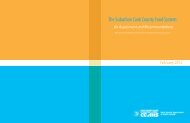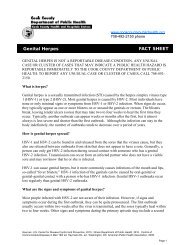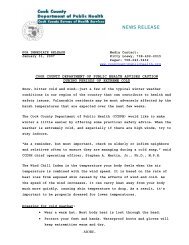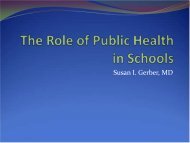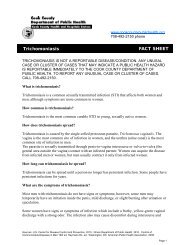Toolkit Overview - Cook County Department of Public Health
Toolkit Overview - Cook County Department of Public Health
Toolkit Overview - Cook County Department of Public Health
You also want an ePaper? Increase the reach of your titles
YUMPU automatically turns print PDFs into web optimized ePapers that Google loves.
AMA, ANA and AAP Recommendations for IPV Assessments and Responses<br />
American Medical Association (AMA)<br />
As stated in the “National Advisory Council on Violence and Abuse: Policy Compendium April<br />
2008” the AMA “recommends that questions to assess risk for family violence should be<br />
included within the context <strong>of</strong> taking a routine social history, past medical history, history <strong>of</strong><br />
present illness, and review <strong>of</strong> systems as part <strong>of</strong> emergency, diagnostic, preventive, and chronic<br />
care management (CSA Rep. 7, A-05)”. The “Policy Compendium” is at:http://www.amaassn.org/ama1/pub/upload/mm/386/vio_policy_comp.pdf<br />
In AMA’s policy statement regarding intimate partner violence titled “E-2.02 Physicians'<br />
Obligations in Preventing, Identifying, and Treating Violence and Abuse”, specific guidelines for<br />
physicians regarding the assessment, treatment and reporting <strong>of</strong> IPV for patients are provided.<br />
The policy states that physicians should be:<br />
1) Routinely assessing for current and past physical, sexual and psychological abuse as part <strong>of</strong><br />
patients’ medical histories, understanding how to detect DV, where to make referrals for<br />
community services, and not being biased by misconceptions about DV;<br />
2) Addressing and treating both short and long term injuries caused by DV with cultural<br />
competence, working in partnership with community resources, developing educational materials<br />
for patients, promoting comprehensive DV training in all medical schools’ curricula,<br />
demonstrating leadership by encouraging peers to routinely assess for DV, support DV research<br />
regarding prevention and establishing collaborations with public health entities and community<br />
organizations; and<br />
3) Following local mandated reporting requirements.<br />
AMA's full policy statement on IPV can be viewed at: https://ssl3.amaassn.org/apps/ecomm/PolicyFinderForm.plsite=www.amaassn.org&uri=%2fama1%2fpub%2fupload%2fmm%2fPolicyFinder%2fpolicyfiles%2fHnE%2fE<br />
-2.02.HTM<br />
American Nurses Association (ANA)<br />
ANA’s The Online Journal <strong>of</strong> Issues in Nursing published an article titled “Clinical Screening<br />
and Intervention in Cases <strong>of</strong> Partner Violence”, and states in its conclusion that “women have<br />
more frequent contact with their health care providers than with any other formal system<br />
including law enforcement, prosecution, social service, or mental health. The nursing pr<strong>of</strong>ession<br />
has potential for having enormous impact on the health and safety <strong>of</strong> women by taking up the<br />
challenge <strong>of</strong> routinely performing violence assessment. Nurses enjoy high patient trust, and their<br />
training in empathy and clinical rapport make them ideal receivers for the disclosure <strong>of</strong> partner






